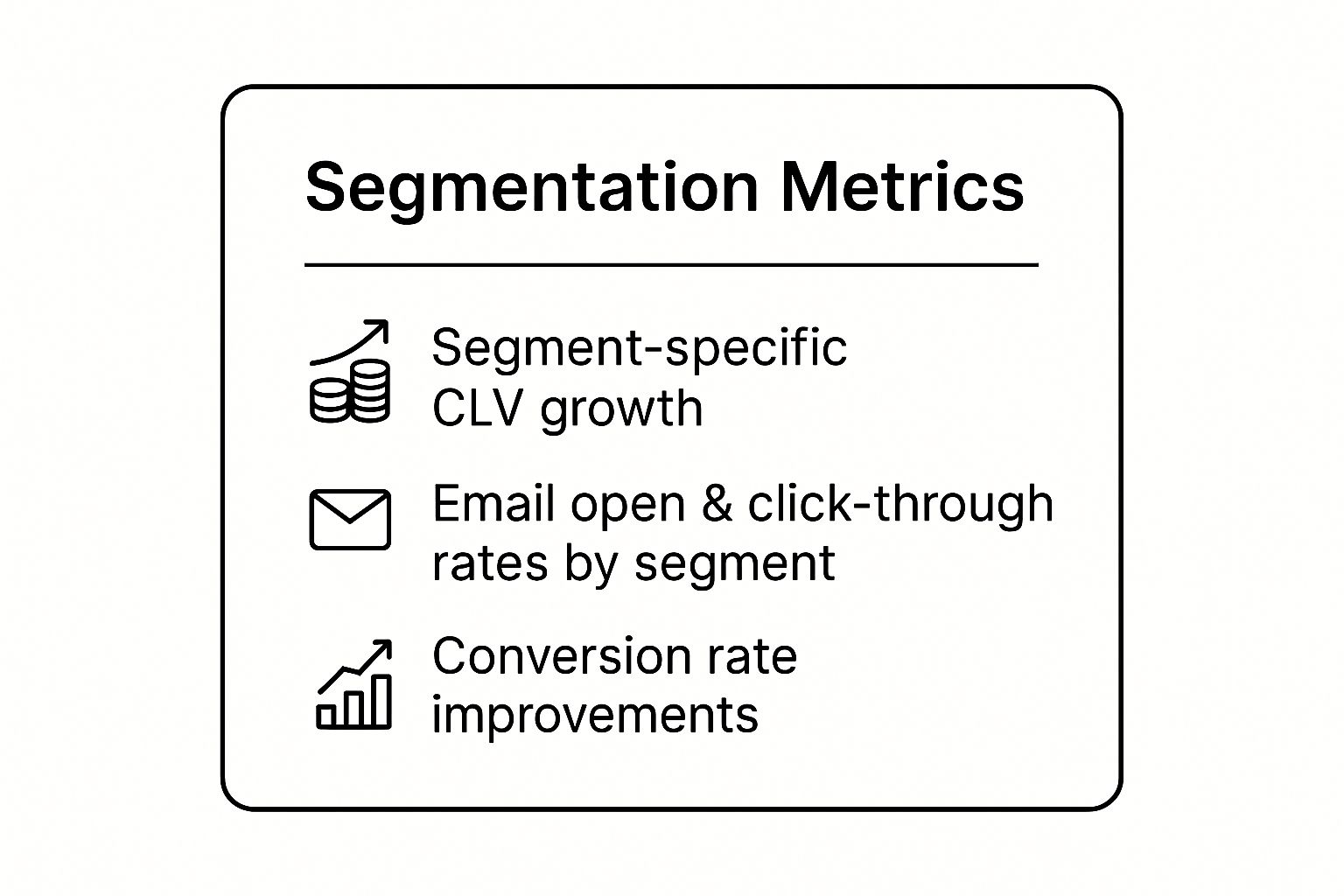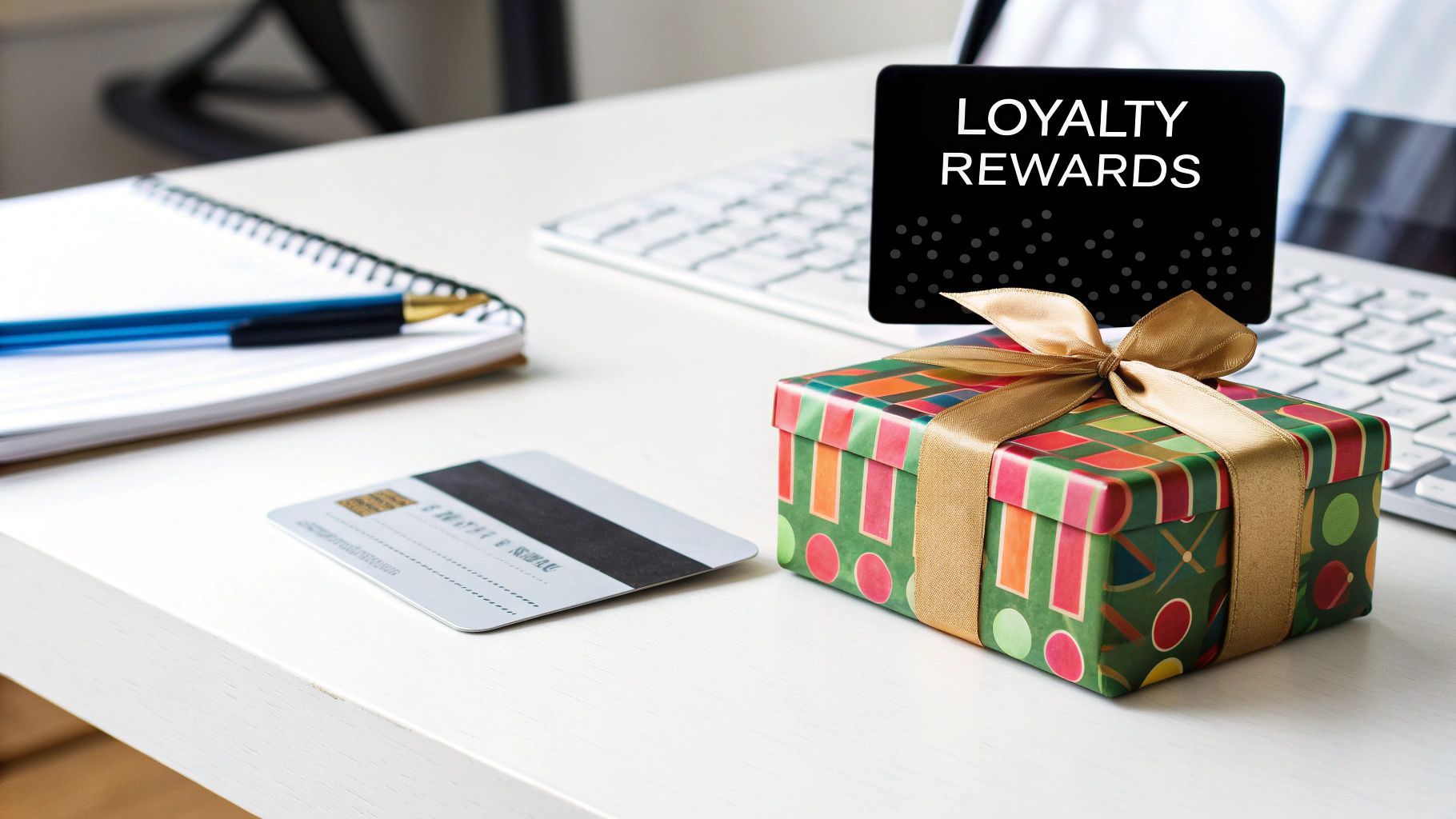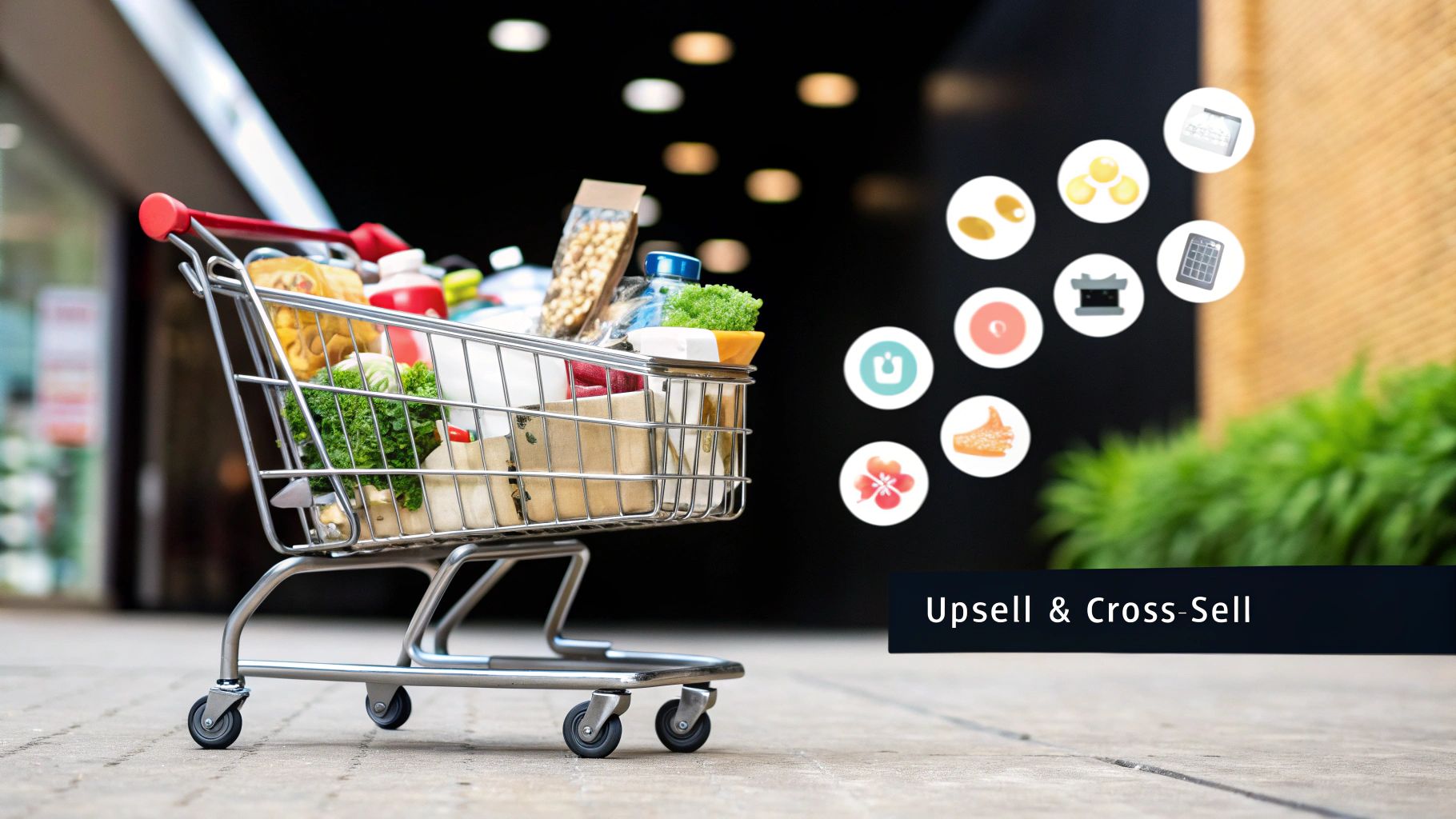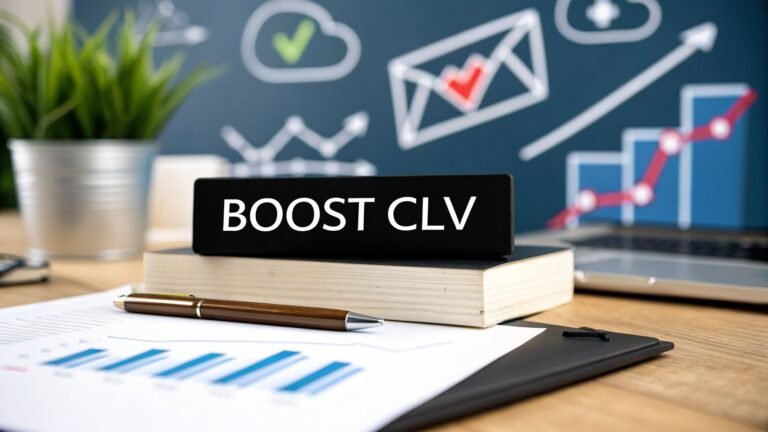In the world of B2B marketing, acquiring a new customer is just the beginning. The real, sustainable growth comes from nurturing that relationship to maximize its long-term potential. This is the core of improving customer lifetime value (CLV), a metric that transforms one-time buyers into loyal, high-value partners.
While many teams focus heavily on top-of-funnel metrics, savvy marketers know the gold is in retention and expansion. A high CLV is a direct indicator of a healthy business model, strong customer satisfaction, and a product that delivers continuous value. Achieving this requires a strategic, deliberate approach, especially within email marketing, where every touchpoint counts. Missteps can lead to disengagement, but a well-executed strategy can turn your email list into your most valuable asset.
This article breaks down eight powerful, actionable strategies designed specifically for B2B email marketers to systematically increase CLV. We'll move beyond generic advice to provide practical steps, real-world examples, and the key metrics you need to track for success. You will learn how to effectively implement:
- Customer Segmentation and Personalization
- Proactive Customer Support
- Loyalty and Rewards Systems
- Cross-selling and Upselling Optimization
- Customer Experience (CX) Excellence
- Subscription and Recurring Revenue Models
- Data-Driven Customer Analytics
- Community Building and Advocacy
Whether you're looking to reduce churn, encourage upgrades, or foster advocacy, these strategies will provide a clear roadmap for building more profitable, lasting customer relationships.
1. Customer Segmentation and Personalization
The first step in improving customer lifetime value (CLV) is to stop treating all your customers the same. Customer segmentation is the practice of dividing your B2B email list into distinct groups based on shared characteristics. Personalization then takes this a step further by tailoring your messaging and offers to meet the specific needs of each segment.
This strategy is powerful because it recognizes that not all customers are created equal. A new lead requires different communication than a loyal, high-spending client. By segmenting, you can focus high-value efforts on your most profitable accounts, nurture at-risk customers, and guide new ones more effectively. This targeted approach makes your marketing more relevant, building stronger relationships and boosting long-term loyalty.
How to Implement Segmentation and Personalization
Getting started with segmentation doesn't have to be complicated. You can begin with basic categories and gradually add more sophisticated layers.
- Start Simple: Group customers by firmographics like company size, industry, or geographic location. This is often the easiest data to access.
- Move to Behavior: Advance to behavioral segmentation by tracking past purchases, email engagement (opens and clicks), and website activity. This tells you what customers do, not just who they are.
- Implement Gradually: Test your personalization strategy on one channel, like email, before expanding. A/B test your subject lines or offers for different segments to validate what works.
- Ensure Data Quality: Your segments are only as good as your data. Regularly clean your lists and update customer information to maintain accuracy.
This targeted approach is a cornerstone of effective B2B strategies. For a deeper dive into applying these principles, you can learn more about how segmentation powers account-based marketing tactics.
The following infographic highlights the key metrics to track when measuring the success of your segmentation efforts.

As the data shows, effective segmentation directly impacts key performance indicators, from engagement rates to the ultimate goal of CLV growth. By delivering the right message to the right audience at the right time, you create a more engaging experience that drives both immediate conversions and lasting value.
2. Customer Success and Proactive Support
Improving customer lifetime value requires a shift from reactive problem-solving to proactive value creation. Customer success is a business methodology focused on ensuring customers achieve their desired outcomes while using your product or service. Instead of waiting for a support ticket, this strategy involves actively guiding, educating, and supporting customers to ensure they realize value quickly and consistently.
This approach is crucial because it directly tackles churn, the biggest enemy of CLV. By monitoring customer health and engaging at the right moments, you can address potential issues before they escalate into cancellations. Companies like Salesforce and HubSpot have built their empires on this principle, understanding that a customer who succeeds with your product is a customer who stays, spends more, and becomes an advocate for your brand.
How to Implement Customer Success and Proactive Support
Building a proactive support model involves a combination of people, processes, and technology. You can start small and scale your efforts as your team grows.
- Establish Customer Health Scores: Create a scoring system based on key metrics like product usage, engagement frequency, and support ticket history. This allows you to identify at-risk accounts and prioritize outreach.
- Standardize Onboarding: Develop a structured onboarding process with clear milestones. A strong start ensures customers understand your product's value from day one, setting them up for long-term success.
- Segment Your Support: Use automation and self-service resources for low-touch segments, freeing up your customer success managers to provide high-touch, personalized support to your most valuable accounts.
- Ensure Clean Communication: A key part of proactive outreach is ensuring your messages are delivered. This begins with maintaining a healthy contact list, a practice you can learn more about through effective email list cleaning strategies.
A well-executed customer success strategy turns your B2B relationships into true partnerships. By investing in your customers' goals, you create a powerful feedback loop that drives loyalty, expansion revenue, and ultimately, a significant increase in customer lifetime value. This focus on long-term partnership is a cornerstone of sustainable business growth.
3. Loyalty Programs and Rewards Systems
Introducing a structured loyalty program is a proactive way to incentivize repeat business and foster long-term engagement. These systems create tangible value for customers who consistently choose your brand, giving them a compelling reason to stay rather than switch to a competitor. By rewarding desired behaviors like repeat purchases or referrals, you actively encourage actions that directly contribute to a higher customer lifetime value.
This strategy works by building both emotional and financial switching costs. Customers become invested in earning the next reward or reaching a new tier, making them less likely to be swayed by a competitor's one-time offer. A well-designed program also provides invaluable data on customer preferences and purchasing habits, allowing for even more effective personalization and targeted marketing efforts.

How to Implement Loyalty and Rewards Programs
An effective loyalty program should feel like a genuine "thank you" to your customers, not a complicated hurdle. The key is to make it simple, valuable, and engaging.
- Make It Simple: The process for earning and redeeming rewards must be transparent and effortless. Customers should easily understand how the program works and see the value they are accumulating.
- Offer Experiential Rewards: While discounts are effective, consider offering exclusive experiences or early access to new products. These non-monetary rewards can build a stronger emotional connection to your brand.
- Use Data to Optimize: Analyze program data to understand which rewards are most popular and at what point customers are most motivated to redeem. Use these insights to refine your offerings and thresholds.
- Integrate Social Sharing: Encourage members to share their rewards or program status on social media. This can amplify visibility and attract new customers through trusted referrals.
For example, Starbucks Rewards has mastered this by integrating its program into a seamless mobile experience, contributing to over 50% of its revenue. Similarly, Sephora's Beauty Insider program is so successful it drives an estimated 80% of the company's annual sales. These programs prove that investing in loyalty is a powerful strategy for improving customer lifetime value and building a sustainable competitive advantage.
4. Cross-selling and Upselling Optimization
One of the most direct ways of improving customer lifetime value is to increase the average order value from your existing customer base. Cross-selling (offering complementary products) and upselling (encouraging an upgrade to a more premium version) are powerful strategies for achieving this. These tactics work because they leverage the trust you have already built with a client.
Instead of acquiring a new customer, you are simply providing more value to a current one. A customer who has already had a positive experience with your business is far more likely to purchase again. By strategically presenting relevant, additional offers, you not only increase revenue per customer but also deepen their integration with your ecosystem, making them less likely to churn.

How to Implement Cross-selling and Upselling
Effective cross-selling and upselling feel helpful, not pushy. The key is to frame your offers as solutions to your customer’s evolving needs.
- Focus on Value, Not Features: Always connect your offer to a clear benefit for the customer. Instead of saying "Upgrade to our Pro plan," explain how the Pro plan's features will help them solve a specific business problem more efficiently.
- Time Your Offers Strategically: Use customer lifecycle data to present offers when they are most relevant. For example, suggest an upgrade when a user is nearing their data limit or cross-sell a related service after they have successfully completed a project using your primary tool.
- Leverage Data and Social Proof: Use purchase history to make personalized, data-driven recommendations. Amazon’s "Frequently bought together" feature is a classic example. Support these suggestions with customer reviews and case studies to build confidence.
- Train Your Team: Equip your sales and support teams to identify natural opportunities during customer conversations. A simple question like, "Did you know we also offer a tool that integrates with this to automate your reporting?" can open the door to a valuable cross-sell.
By optimizing these sales motions, you tap into a reliable revenue stream. It is a core component of the "land and expand" strategy famously used by companies like Salesforce, where an initial sale is just the beginning of a long and profitable relationship. This approach is fundamental to maximizing the potential of every customer account.
5. Customer Experience (CX) Excellence
Improving customer lifetime value goes beyond the product or service itself; it’s about the total experience a customer has with your brand. Customer Experience (CX) Excellence is the practice of designing and delivering consistently positive, memorable, and valuable interactions at every single touchpoint. It’s a holistic strategy that focuses on understanding and meeting customer needs and emotions throughout their entire journey with your company.
This approach is crucial because a superior experience is a powerful differentiator in a crowded B2B market. When customers feel understood and valued, they are more likely to stay loyal, expand their business with you, and become advocates for your brand. Companies like Apple and Zappos have built empires not just on their products, but on the exceptional experiences they deliver, turning routine transactions into lasting relationships and significantly improving customer lifetime value.
How to Implement Customer Experience Excellence
Building a world-class customer experience requires a systematic and empathetic approach. You can start by focusing on key areas that have an immediate impact on how customers perceive your brand.
- Map the Customer Journey: Document every interaction a customer has with your company, from their first website visit to post-purchase support. Identify their goals, pain points, and emotional state at each stage.
- Empower Frontline Teams: Give your customer-facing employees the authority and training to resolve issues on the spot. An empowered employee can turn a negative experience into a positive one, building immense goodwill.
- Act on Feedback: Systematically collect customer feedback through surveys, reviews, and direct conversations. More importantly, use this data to prioritize and implement meaningful improvements.
- Invest in Your Team: A great customer experience starts with a great employee experience. Invest in training and tools to ensure your team is engaged, knowledgeable, and motivated to serve customers well.
By focusing on the entire journey, you can create a seamless experience that enhances loyalty. This principle is closely related to the micro-improvements that drive success, and for a deeper look into optimizing each touchpoint, you can learn more about how these ideas power conversion rate optimization tips.
6. Subscription and Recurring Revenue Models
A powerful strategy for improving customer lifetime value is to shift your business model away from one-time transactions toward ongoing relationships. Subscription and recurring revenue models transform the customer dynamic by focusing on continuous value delivery. Instead of a single purchase, customers pay a recurring fee for consistent access to a product or service, creating a predictable and stable revenue stream.
This approach inherently prioritizes retention over acquisition. Success is no longer measured by a single sale but by the ability to keep a customer engaged and satisfied month after month. Companies like Salesforce, which pioneered the SaaS subscription model, and Adobe, with its shift to Creative Cloud, demonstrated that this focus on long-term relationships directly translates to exponential growth in company valuation and customer loyalty. This model ensures you are constantly aligned with your customers' evolving needs.
How to Implement a Subscription Model
Transitioning to a recurring revenue model requires a strategic approach focused on delivering sustained value. It's about building a service, not just selling a product.
- Offer Tiered Options: Create multiple subscription levels to cater to different customer segments. A basic tier can attract new users, while premium tiers can provide advanced features for high-value accounts, allowing for clear upgrade paths.
- Focus on Onboarding: The first few weeks are critical. A seamless and effective onboarding process that demonstrates immediate value is essential for preventing early churn and setting the stage for a long-term relationship.
- Start with a Pilot: Test the viability of your subscription idea with a small, dedicated group of customers. This allows you to gather feedback, refine your offering, and validate pricing before a full-scale launch.
- Track Usage and Engagement: Implement robust analytics to monitor how customers are using your service. This data is crucial for identifying at-risk accounts, spotting opportunities for upselling, and informing future product development.
This model fundamentally changes your business from making a sale to earning a customer's loyalty every month. By building a predictable revenue engine, you create a more stable foundation for growth while embedding your solution into your customer's daily operations, which is a key driver for improving customer lifetime value.
7. Data-Driven Customer Analytics and Insights
Going beyond basic reporting, data-driven customer analytics involves systematically collecting, analyzing, and acting on customer data to understand behavior patterns and predict future actions. This strategy uses advanced analytics to turn raw information into a roadmap for optimizing the entire customer experience. By uncovering deep insights, you can anticipate needs, prevent churn, and identify upselling opportunities before they even surface.
This approach is crucial for improving customer lifetime value because it replaces guesswork with evidence. Instead of assuming what your customers want, you can see their preferences reflected in their behavior. This allows for hyper-personalized marketing, proactive service, and strategic business decisions that are aligned with real-world customer needs, ultimately fostering deeper loyalty and higher spending over time.
How to Implement Data-Driven Analytics
Adopting a data-driven culture requires a structured approach to ensure the insights you generate are both accurate and actionable.
- Start with Clear Questions: Before diving into data, define the business problems you want to solve. Are you trying to reduce churn, increase repeat purchases, or identify your most valuable customer segments?
- Invest in Data Quality: Ensure your data is clean, accurate, and consolidated. Poor data quality leads to flawed insights and misguided strategies. Start with good governance from day one.
- Combine Data Types: Integrate quantitative data (purchase history, website clicks) with qualitative feedback (surveys, support tickets) for a complete 360-degree view of your customer.
- Focus on Actionable Insights: Avoid "vanity metrics" that look good but don't drive decisions. Concentrate on analytics that provide clear, actionable steps to improve customer relationships and profitability.
Understanding the balance between what you spend to acquire a customer and the value they bring is a critical first step. You can explore this further and see how data informs your budget with this helpful customer acquisition cost calculator. By leveraging analytics, you ensure every marketing dollar is invested wisely to maximize long-term returns.
8. Community Building and Customer Advocacy
A powerful strategy for improving customer lifetime value is to transform customers from passive buyers into active brand advocates. This is achieved by building an engaged community where users can connect with each other and your brand. These communities foster a sense of belonging and provide a platform for customers to share experiences, offer peer support, and champion your products.
This approach is highly effective because it creates a self-sustaining ecosystem of loyalty. An active community reduces the burden on your support teams, generates authentic user-generated content, and provides invaluable feedback for product development. When customers feel like part of a tribe, their relationship with your brand deepens, leading to higher retention, increased spending, and powerful word-of-mouth marketing.
How to Implement Community and Advocacy Programs
Building a thriving community requires a dedicated and strategic effort, not just a passive forum. You can start small and scale your initiatives as engagement grows.
- Provide a Dedicated Space: Create an exclusive online forum, a private social media group, or a dedicated Slack channel for your customers. This gives them a central place to connect, like Salesforce has done with its successful Trailblazer Community.
- Empower a Community Manager: Hire a dedicated manager who understands your customers and is passionate about facilitating conversations, providing resources, and enforcing community guidelines.
- Recognize and Reward Advocates: Acknowledge your most active and helpful members. Offer them exclusive perks, early access to new features, or public recognition. This encourages continued participation and reinforces positive behavior.
- Integrate Feedback Loops: Actively listen to discussions within your community. Use these insights to inform your product roadmap and business strategy, showing customers that their voice is heard and valued.
By fostering a genuine community, you create a powerful flywheel effect. Engaged members not only remain loyal customers but also become your most effective marketers, directly contributing to long-term CLV growth by attracting new, high-quality customers to your brand.
8 Strategies for Enhancing Customer Lifetime Value
| Strategy | Implementation Complexity | Resource Requirements | Expected Outcomes | Ideal Use Cases | Key Advantages |
|---|---|---|---|---|---|
| Customer Segmentation and Personalization | High – requires data infrastructure and multi-channel integration | Significant data management and analytics expertise | Increased engagement, higher conversion, personalized experiences | Businesses with diverse customer bases and rich data | Improved marketing efficiency, customer loyalty |
| Customer Success and Proactive Support | Medium to high – needs dedicated teams and processes | Specialized teams, customer health monitoring tools | Reduced churn, higher satisfaction, upsell opportunities | SaaS, subscription models, B2B with complex products | Stronger relationships, proactive churn prevention |
| Loyalty Programs and Rewards Systems | Medium – program design and ongoing management | Operational support, marketing resources | Increased retention, repeat purchases, switching costs | Retail, hospitality, consumer brands | Customer retention, rich data, premium pricing |
| Cross-selling and Upselling Optimization | Medium – dependent on AI and sales training | AI tools, sales enablement resources | Higher revenue per customer, expanded wallet share | E-commerce, retail, SaaS | Higher margins, predictable revenue, customer value expansion |
| Customer Experience (CX) Excellence | High – requires organizational alignment and consistent execution | Investment in training, feedback systems, journey mapping | Strong brand loyalty, premium pricing, reduced service costs | Brands seeking differentiation in competitive markets | Emotional connection, advocacy, long-term loyalty |
| Subscription and Recurring Revenue Models | High – needs billing automation and continuous product updates | Technology platforms, customer success, marketing | Predictable revenue, higher lifetime value, scalable growth | Digital services, SaaS, media streaming platforms | Recurring revenue, cash flow stability, retention |
| Data-Driven Customer Analytics and Insights | High – advanced analytics, machine learning, data governance | Data scientists, advanced technology investments | Precise targeting, improved decision-making, churn prediction | Large data-rich enterprises focused on optimization | Actionable insights, marketing ROI improvement |
| Community Building and Customer Advocacy | Medium – ongoing community management and moderation | Community managers, content resources | Brand loyalty, organic marketing, peer support | Brands aiming for engagement and advocacy | Authentic engagement, reduced support costs |
From Strategy to Sustainable Growth
We've journeyed through eight powerful strategies, from the granular details of customer segmentation to the broad vision of community building. Each tactic represents a critical component in the complex engine of improving customer lifetime value. Seeing these as isolated tasks is a common mistake; their true potential is only unlocked when they are integrated into a cohesive, customer-centric philosophy.
Think of it as building a fortress of loyalty. Your data analytics and insights are the foundation, giving you a clear view of the landscape. Proactive customer success and a world-class customer experience are the strong walls, protecting your relationships from churn. Finally, loyalty programs, upselling, and community advocacy are the towers, actively expanding your influence and generating new growth.
Synthesizing the Strategies for Maximum Impact
The core message weaving through every point is this: value precedes revenue. Before you can ask for the next sale or the subscription renewal, you must consistently deliver exceptional value. This isn't just about your product's features; it's about making your customer feel understood, supported, and appreciated at every turn.
- Personalization shows you know who they are.
- Proactive Support proves you have their back.
- Loyalty Rewards thank them for their business.
- Strategic Upsells guide them toward greater success.
When these elements work together, customers stop seeing your emails as marketing and start seeing them as valuable, personalized advice. This shift is the very essence of improving customer lifetime value, transforming a transactional relationship into a long-term partnership.
Your Actionable Blueprint for Increasing CLV
Reading about these strategies is the first step, but action is what drives results. Don't feel overwhelmed by the need to implement everything at once. Sustainable growth comes from focused, iterative improvements.
Here is a practical, three-step plan to get started:
- Start with Your Foundation – Data Integrity: Before launching any new initiative, audit the health of your email contact list. Effective communication is impossible if your messages don't land in the inbox. Use a trusted tool to verify your B2B email data, remove invalid contacts, and protect your sender reputation. This single action will amplify the effectiveness of every subsequent strategy.
- Choose Your First Lever – Pick One High-Impact Area: Review the eight strategies and identify the one that addresses your biggest current weakness or offers the greatest opportunity. Are you struggling with churn? Focus on proactive customer success. Is your revenue per customer flat? Develop a data-driven upselling and cross-selling program. Master one before adding another.
- Measure, Learn, and Iterate: Define the key metrics you will use to track success. This could be repeat purchase rate, churn rate, Net Promoter Score (NPS), or the CLV calculation itself. Set a baseline, implement your chosen strategy for a specific customer segment, and measure the impact after a set period (e.g., 90 days). Use what you learn to refine your approach and then expand it.
The Ultimate Reward: A Resilient, Predictable Business
Ultimately, the relentless focus on improving customer lifetime value does more than just increase a metric on a dashboard. It builds a more resilient, predictable, and profitable business. It frees you from the frantic, expensive cycle of constantly chasing new leads and allows you to build sustainable growth on the bedrock of customer loyalty.
By investing in the customers you already have, you are creating a flywheel of success. Happy, loyal customers not only spend more over time, but they also become your most effective marketing channel, bringing in new, high-quality leads through word-of-mouth and advocacy. This is the path from short-term tactics to long-term, sustainable growth. The journey begins now.

